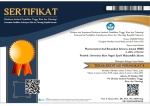Uji Efek Imunomodulator Ekstrak Biji Karika (Carica pubescens Lenne K. Koch) terhadap Peningkatan Aktivitas Fagositosis pada Mencit Putih Swiss Webster
Abstract
Tumbuhan dari keluarga Caricae telah diketahui mempunyai aktivitas sebagai antelmintik, antihiperkolesterol, antibakteri, antioksidan, dan aktivitas farmakologis lain yang berhubungan dengan sistem imun. Tumbuhan karika merupakan salah satu keluarga Caricaceae dan belum banyak diteliti. Kandungan flavonoidnya diketahui lebih tinggi dibandingkan buah pepaya. Penelitian ini bertujuan untuk menskrining aktivitas imunomodulator ekstrak biji karika berdasarkan konstanta fagositosisnya menggunakan metode bersihan karbon. Maserasi dengan pelarut etanol 96% digunakan untuk menarik metabolit sekunder biji karika. Penelitian dilakukan dengan membagi 5 kelompok perlakuan pada hewan uji yaitu kelompok positif Pyllanthus niruri, kelompok negative, serta kelompok perlakuan ekstrak biji karika (EBK) dosis 125, 250, dan 500 mg/kgBB. Hasil penelitian menunjukkan terdapat pengaruh pemberian variasi dosis EBK terhadap kecepatan eliminasi tinta karbon. Biji karika dosis 500 mg/kgBB mempunyai aktivitas sebanding dengan kontrol positif Pyllanthus niruri (p<0,05) sebagai imunostimulan.
Keywords
References
Altizer, S., Bartel, R., & Han, B. A. (2011). Animal migration and infectious disease risk. science, 331(6015), 296-302.
Alasvand, M., Assadollahi, V., Ambra, R., Hedayati, E., Kooti, W., & Peluso, I. (2019). Antiangiogenic effect of alkaloids. Oxidative medicine and cellular longevity, 2019.
Bhargava, P., & Lee, C. H. (2012). Role and function of macrophages in the metabolic syndrome. Biochemical Journal, 442(2), 253-262.
Cruvinel, M. W., Mesquita, J. D., Araújo, J. A., Catelan, T. T., & Andrade, L. E. (2010). Immune system-part I. Fundamentals of innate immunity with emphasis on molecular and cellular mechanisms of inflammatory response. Revista brasileira de reumatologia, 50(4), 434-461.
Fabricant, D. S., & Farnsworth, N. R. (2001). The value of plants used in traditional medicine for drug discovery. Environmental health perspectives, 109(suppl 1), 69-75.
George, A., Chinnappan, S., Choudhary, Y., Bommu, P., & Sridhar, M. (2014). Immunomodulatory activity of an aqueous extract of Polygonum minus Huds on Swiss albino mice using carbon clearance assay. Asian Pacific Journal of Tropical Disease, 4(5), 398-400.
Hosseinzadeh, H., & Nassiri-Asl, M. (2014). Review of the protective effects of rutin on the metabolic function as an important dietary flavonoid. Journal of endocrinological investigation, 37(9), 783-788.
Julianti, T., Oufir, M., & Hamburger, M. (2014). Quantification of the antiplasmodial alkaloid carpaine in papaya (Carica papaya) leaves. Planta medica, 80(13), 1138-1142.
Kharisma, Y., Ariyoga, A., & Sastramihardja, H. S. (2011). Efek ekstrak air buah pepaya (Carica papaya L.) muda terhadap gambaran histologi kelenjar mamma mencit laktasi. Majalah Kedokteran Bandung, 43(4), 160-165.
Laily, A. N., Suranto, S., & Sugiyarto, S. (2012). Characterization of Carica pubescens in Dieng Plateau, Central Java based on morphological characters, antioxidant capacity, and protein banding pattern. Nusantara Bioscience, 4(1).
Lestari, D., Sukandar, E. Y., & Fidrianny, I. (2015). Anredera cordifolia leaves extract as anti-hyperlipidemia and endothelial fat content reducer in male Wistar rat. Int. J. Pharm. Clin. Res, 7(6), 435-439.
Pandey, S., Cabot, P. J., Shaw, P. N., & Hewavitharana, A. K. (2016). Anti-inflammatory and immunomodulatory properties of Carica papaya. Journal of immunotoxicology, 13(4), 590-602.
Pérez-Cano, F., & Castell, M. (2016). Flavonoids, inflammation and immune system.
Mekenyan, E., Stancheva, N., & Tisheva, S. (2012). Changes in the immunologic markers of elastin degradation in subjects with metabolic syndrome. Journal of IMAB–Annual Proceeding Scientific Papers, 18(3), 345-348.
Minarno, E. B. (2015). Skrining fitokimia dan kandungan total flavanoid pada buah carica pubescens lenne & k. Koch di kawasan bromo, cangar, dan dataran tinggi dieng. el–Hayah, 5(2), 73-82.
Mu’awwanah, A., & Ulfah, M. (2017). Uji aktivitas antioksidan fraksi n-heksan ekstrak etanol daun karika (carica pubescens) dan identifikasi senyawa alkaloid dan flavonoidnya. e-Publikasi Fakultas Farmasi, 118-124.
Novalina, D., Sugiyarto, S., & Susilowati, A. (2018). Aktivitas antibakteri kulit buah karika dieng terhadap shigella flexneri dan escherichia coli. Jurnal Teknologi Laboratorium, 7(2), 53-60.
Skidgel, R. A., Kaplan, A. P., & Erdös, E. G. (2011). Histamine, bradykinin, and their antagonists. Goodman & Gilman’s the pharmacological basis of therapeutics. 12th ed. New York, NY: McGraw Hill, 911-935.
Supono, S., Susilowati, A., Purwantisari, S. U. S. I. A. N. A., & Kurniawati, F. N. (2015). Biokontrol Larva nyamuk aedes aegypti menggunakan limbah biji karika (vasconcellea pubescens). Pros Sem Nas Biodiv Indon, 1(5), 27-31.
Yang, J., Cai, X., Lu, W., Hu, C., Xu, X., Yu, Q., & Cao, P. (2013). Evodiamine inhibits STAT3 signaling by inducing phosphatase shatterproof 1 in hepatocellular carcinoma cells. Cancer letters, 328(2), 243-251.
DOI: 10.15408/pbsj.v2i1.14436
Refbacks
- There are currently no refbacks.






